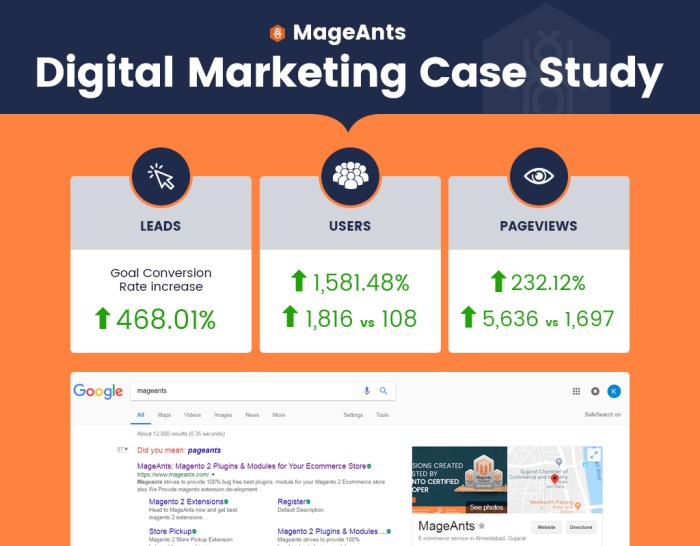Marketing with Case Studies sets the stage for innovative marketing strategies, utilizing real-world examples to captivate audiences and drive success in the competitive business landscape. From defining the power of case studies to exploring their impact on brand awareness, this discussion delves deep into the realm of marketing creativity and effectiveness.
Introduction to Marketing with Case Studies

Case studies in marketing are detailed examinations of specific marketing strategies, campaigns, or tactics that have been implemented by companies to achieve certain objectives. These studies provide a real-world example of how a particular marketing approach was executed and the results that were achieved.Using case studies in marketing strategies is crucial because they offer valuable insights into what works and what doesn’t in the marketing world.
By analyzing successful case studies, marketers can learn from past experiences, avoid common pitfalls, and adapt proven strategies to their own campaigns.
Importance of Using Case Studies in Marketing, Marketing with Case Studies
- Case studies provide tangible examples of successful marketing tactics in action.
- They offer practical insights that can be applied to similar situations.
- Case studies help build credibility and trust with potential customers by showcasing real results.
- They serve as valuable educational tools for marketing professionals to learn from others’ successes and failures.
Examples of Successful Marketing Campaigns with Case Studies
Apple’s “Shot on iPhone” campaign is a prime example of a successful marketing campaign that utilized case studies. By showcasing stunning photos taken by iPhone users, Apple demonstrated the quality of its camera technology in real-world scenarios, leading to increased sales and brand loyalty.
The Dove Real Beauty campaign is another notable case study in marketing. By featuring real women of all shapes and sizes in their ads, Dove challenged traditional beauty standards and resonated with a diverse audience, resulting in a significant boost in sales and positive brand perception.
Creating Compelling Case Studies
Creating a successful marketing case study requires attention to detail and a strategic approach. Here are some essential elements to consider when crafting a compelling case study:
Essential Elements of a Successful Marketing Case Study
- Clear Objective: Define the purpose and goals of the case study upfront to guide the content.
- Customer Story: Focus on the customer’s journey, challenges faced, and solutions provided.
- Data and Evidence: Use real data, statistics, and testimonials to support your claims and add credibility.
- Visual Appeal: Incorporate visuals like charts, graphs, and images to make the case study more engaging.
- Results and Impact: Highlight the outcomes achieved and the positive impact of your product or service.
Tips for Structuring a Case Study for Maximum Impact
- Start with a compelling title and introduction to grab the reader’s attention.
- Provide background information on the customer and their industry to set the context.
- Artikel the challenges faced by the customer and how your solution addressed them.
- Showcase the implementation process and key steps taken to achieve success.
- Highlight measurable results, such as increased sales, ROI, or customer satisfaction.
Examples of Different Formats for Presenting Case Studies
- Written Case Studies: Traditional format with text, headings, and visuals to present the information.
- Video Case Studies: Engaging video content featuring customer interviews, product demos, and outcomes.
- Infographic Case Studies: Visual representations of data, statistics, and key points for easy consumption.
Leveraging Case Studies for Brand Awareness
Case studies play a crucial role in building brand credibility and trust by showcasing real-life examples of successful outcomes. When potential customers see how your product or service has helped others overcome challenges and achieve their goals, it can instill confidence in your brand.
Strategies for Promoting Case Studies
- Utilize social media platforms to share case studies with a wide audience.
- Include case studies in email marketing campaigns to engage existing customers and prospects.
- Feature case studies on your website to provide easy access to valuable content for visitors.
- Collaborate with industry influencers to promote your case studies to a larger audience.
Examples of Brands Using Case Studies
HubSpot:
HubSpot effectively uses case studies to highlight how their marketing automation software has helped businesses increase leads and revenue.
Dollar Shave Club:
Dollar Shave Club’s case studies showcase customer testimonials and success stories, helping to build trust and credibility in their subscription service.
Peloton:
Peloton’s case studies feature real customers sharing their fitness journey and how the brand’s products have transformed their lives, resonating with their target audience.
Measuring the Impact of Case Studies: Marketing With Case Studies

When it comes to measuring the impact of case studies in a marketing campaign, there are several key metrics that can help determine their effectiveness. By tracking these metrics, companies can gain valuable insights into the success of their case study efforts.
Key Metrics to Measure Effectiveness
- Conversion Rate: Tracking the percentage of leads that convert into customers after engaging with a case study.
- Engagement Metrics: Monitoring metrics such as time spent on the case study page, scroll depth, and social shares.
- Lead Generation: Measuring the number of new leads generated as a result of a case study.
Tools and Methods for Tracking Performance
- Google Analytics: Utilizing Google Analytics to track website traffic, user behavior, and conversions related to case studies.
- CRM Systems: Integrating case study performance data into Customer Relationship Management systems to analyze customer interactions.
- Social Media Analytics: Monitoring social media engagement and reach of case studies across different platforms.
Examples of Evaluating ROI
- Company A saw a 30% increase in sales after releasing a case study highlighting a successful customer story.
- Company B tracked a 50% rise in website traffic directly attributed to a case study campaign targeted at a specific industry.
- Company C measured a 25% improvement in brand awareness following the publication of a series of impactful case studies.

